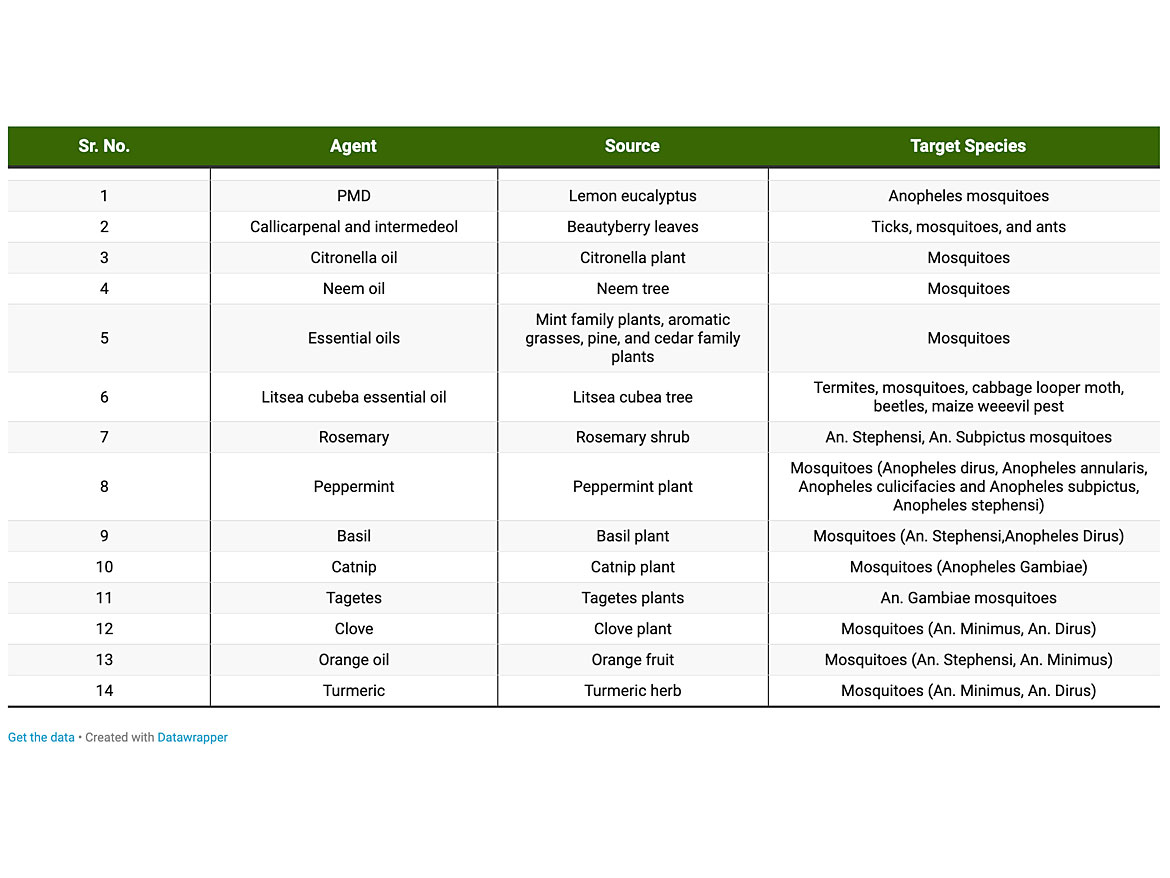Natural Insect Repellant Fragrances and Potential Use in Interior Architectural Coatings

Blair_witch, iStock / Getty Images Plus, via Getty Images
There is a huge biodiversity of species on the planet Earth. Insects of different species are an important constituent of this biodiversity. As the predominant species on the planet, human beings are often in conflict with other species on the planet. Insects are no exception to that. They have been known to be present on the earth for 480 million years1, even before human beings. Various insect species have adapted to different environments. Ever since humankind began modifying its own environment to suit its comforts, new species of insects emerged2. These insects thrive on the ecological systems created as a result of human activity. Also, a lot of insect species that were not dependent on these ecological systems have migrated to these ecologies due to suitability in terms of environment, temperature conditions, and easy access to a variety of nutrients that are discarded as a result of large-scale human activity.
Ever since their interaction with insects, human beings have tried to fend off these insects using a wide variety of methods. These methods range from age-old practices of fragrances of naturally obtained agents, barriers, such as windows, meshes of different material, to simply killing the insects with more modern methods like fly catchers or insecticides.
While modern methods are known to be efficient, there are some concerns with them. Fly catchers work on a selected species that are known to be attracted to a certain stimulus (for example, light). Insecticides used upon insects may often find their way into human food chain by means of bioaccumulation. It may cause further ailments in human beings, while there is a worldwide demand for pesticide-free, organically grown agricultural products for human and cattle consumption. These chemical agents often end up in the water systems (rivers, lakes, and underground acquirers), straining the freshwater resources available to flora and fauna of the Earth.
These chemical agents used to kill insects have often acted as agents to increase the immunity of insects towards them. Consequently, higher dosages of these repellants are often required to achieve the same effect. Biological activities of insects that are not the targets, such as bees, are also impacted negatively3.
So, this has led to the search for new methods of obtaining an insect-free atmosphere without these harmful chemical agents. Fragrances obtained from natural agents (like plants and vegetation) present a promising case. Such fragrances have been employed by human beings for many years to repel insects.
Background
Utilization of fragrances is a centuries-old practice, from hanging bruised plants in houses to burning leaves to drive away mosquitoes. These practices are still prevalent in developing countries4. These crude fumigants were later used in oil formulations to be applied on clothes and skin, as recorded by ancient Greek, Roman, and Indian Scholars5,6,7. Insects possess ciliated dendrites of odor receptor neurons (ORN) that can be found externally (for example antennae).These odor receptors bind with volatile odor molecules, and can be blocked by synthetic repellants such as DEET (N, N-diethyl-3-methylbenzamide)8.To deter herbivores, plants produce “green leaf volatiles” when leaves are damaged9.These volatile compounds, including geranyl acetate and citronella,6-methyl-5- hepten-2-one and geranyl acetone, are known to be a stimuli for mosquito odor receptors9,10,11.These volatiles are also toxic repellants to insects12,13.
These repellants can be added to functional surface coatings for obtaining insect-free building interiors. The practice of encapsulating fragrance in interior architectural coatings has gained popularity in recent years, primarily for masking off the smell of paint or solvent used. This trend gives us a new opportunity. We can encapsulate these fragrances with a slow-releasing mechanism to provide an insect-free atmosphere as well as the aroma of natural surroundings14.
Various fragrances, their sources and the target species are furnished in Table 1.

TABLE 1 ǀ Fragrances, sources, and target organisms.
Using Fragrances in Architectural Coatings
This section discusses the application of fragrances in surface coatings. Different methodologies are available to incorporate insect-repellent fragrances in surface coatings.
Encapsulation
The encapsulation method was first employed to produce microcapsules of dyes used in the paper printing industry15. The method is employed to control the release rate of volatile fragrances. The release mode can be made steady or cyclical over a limited time. The release can also be made to be dependent on the external environmental conditions or some external stimuli such as pressure16.The release rate of encapsulated molecules is governed by Fick’s law of diffusion. The equation can be given as follows:
Release rate =d(Mass of agent released)/ d(time)=Surface Area/H
where H = surface area of diffusion barrier*Coefficient of diffusion of encapsulated agent (Saturation Solubility of encapsulated agent (-) K, and K = Partition coefficient of barrier with surrounding*concentration of encapsulated species in the surrounding environment)
Encapsulation of fragrances for adding functionality to architectural paint is a recent trend14. The process involves adding a diffusion barrier around the fragrance molecule. The most common polymers used for creating this diffusion barrier or simply a shell around the fragrance molecule include polymers of melamine formaldehyde, polyurethane, urea formaldehyde, either alone or in combination with urea, methyl methacrylate, vinyl alcohol, chitosan, polysaccharides, etc.
Different fragrance molecules will have different release rates and duration of release depending on the morphology of the encapsulated fragrance particles17.
The encapsulated polymers can be added in the letdown stage of mixing at slow shear rates without compromising the stability of the encapsulated polymer18.
The incorporation of this encapsulated emulsion is similar to the addition of any other binder emulsion in the paint formulation. Some examples of encapsulation in paints include interior decorative paints of certain reputed companies. These paints have fragrance-encapsulated emulsions for masking the odor during the initial curing process.
The perception levels of fragrances will vary across species, ranging from humans to insects. K.E. Kaissling has thrown light upon nose sensitivity of various species such as dogs, humans, moths, etc. He has expressed that the capture coefficient of receptor cells of noses and antennae for different odorants are different for every species19. This presents us with an opportunity to adjust the dosage levels for greater protection from insects while keeping the perception of humans at lower levels.
Matrix Encapsulation
The polymer matrix consisting of core and aqueous shell can be prepared by various chemical methods20-25. The fragrance molecules form the core, while the shell polymer allows the release of fragrance molecules.
Chemical binding involves reaction of derivatives of active agent with a polymer such as cellulose. For example:
First Step: Carboxyl acid derivative of Active Agent+ Phosgene (CoCl2) Active Agent-CoCl
Second Step: Active Agent-CoCl + Cellulose Active Agent-OCO-Cellulose
This is the most used technique. The active agent is entrapped within the barrier polymer like a matrix. The individual particles (solid, liquid, or gas) of active/release agent are not coated with the barrier polymer. An inorganic filler that serves as a medium or vehicle is also often added in this technique 16.
Potential Benefits of Using Insect-Repellent Fragrances in Surface Coatings
The existing technologies focus on employing commercially available insecticides and pesticides. One of the reasons for the popularity of these agents is the predictability of outcomes with respect to insect repellant action 26.
Their dosages are kept at certain limits owing to their potential of encroaching on human health. So, a support ecosystem of agencies that can certify these levels to be safe (according to prevalent regional laws) also exists. For example, recommended upper dosage levels for DEET in a mosquito repellant are at 30%. Beyond a particular concentration, the efficacy of these repellents have no increased efficacy.
Going ahead with the use of the biocidal agents, it is only a matter of time before the current popular levels of dosages of these would prove to be ineffective against the target insects. Most of the biological species have the ability to develop immune response to biocides that consistently attempt to reduce their population2.
While the benefits of natural repellant fragrances have been known to mankind for years, suitable methods of extracting these advantages are still a topic of exploration in modern urban environments. The closest we have come to a prevalent, real-world use of these fragrances involves devices that can volatilize essential oils by an electric heating mechanism. However, it is not very popular as it involves refilling the device every time an essential oil is consumed. These devices, although more ecofriendly than the widely popular electric heat-operated mosquito repellants, find it difficult to gain popularity in modern homes. This is due to their high volatility that would require huge storage quantities for reproducible results.
In our discussion we have seen the utility of encapsulation to extract these benefits in a convenient way in modern urban environments. Human surroundings can be altered to repel insects by a one-time solution, instead of storing huge quantities or frequent refilling. Encapsulation presents the possibility of controlling the volatile release rates of these natural agents. The longevity of release phenomenon can be extended from a few months to a year, or even longer14.
Surface coatings containing the encapsulated polymer can be applied to masonry walls, plastics, wood, ceilings, doors, or any other substrate that constitutes a closed environment. The methods of application are similar to methods employed for traditional architectural coatings for the substrates discussed.
The closed environment will always have a certain concentration of these natural agents in the enclosed air. The diffusion rate of fragrances can be automatically regulated, depending on the concentration of the fragrance molecule in the air surrounding the surface coating. The surface coating will free the user of any need to stock up the fragrance agents or having to worry about the impact of the insect repellant agents on his/her health. An aware user will also take the convenient, ecofriendly option against the chemical biocides.
The surface coating(s) will also provide an added benefit of subjective likeliness of aroma, like a simulated natural environment on the concrete walls in his/her surroundings. People are already opting for fragrances to mask the smell of solvents (if any) and polymeric binders in surface coating systems.
Widespread adoption of encapsulated polymeric systems in surface coatings will help reduce the production and consumption of insecticides. Also, we will have a better chance of reducing the impact of chemical agents such as DEET, DEPA, etc. on the immunity of insect species. This will also have a far-reaching impact on the rate at which pesticides and insecticides are used at incremental dosages in other relevant areas, such as agriculture26.
Bioaccumulation and Biomagnification
There is a prospect of these agents to become ineffective against insects until the limits of the dosages are revised to suit the new immune response levels of the biological species. However, that would be again a question of their impact on human life and on other biological species human beings coexist with, taking a broader, rational view of these legal or statutory limits. There are concerns related to bio accumulation and bio magnification27.
Bio accumulation in an organism occurs when it absorbs a pesticide at a rate that is greater than the rate at which it releases the pesticide by excretion or catabolism. Even if the environmental levels of the pesticide or insecticide are not high, there is a chance of bioaccumulation as the half-life of the agent increases. Bio accumulation of mercury in fish is a widely discussed phenomenon.
Biomagnification refers to an increase in the concentration levels of a substance in organisms that are situated at higher trophic levels in a food chain. While the process of magnification is essential for growth, it becomes detrimental to the growth of the organisms when it occurs with the accumulation of pesticides or insecticides.
Use of natural insect repellants will affect the olfactory systems of insects, while being a safer alternative to bioaccumulation of pesticides.
Conclusion
In the search for alternative methods to repel insects, fragrances obtained naturally are an option that can be explored. The multiple sources of essential oils and plant extracts can be used either alone or in combination in architectural coatings (especially for interior) to achieve efficacy of the commercially available insecticides. The insecticides often create strong immunity in insects, leading to the need of increasing the dosage levels, while also posing a threat to human health and ecological systems. Fragrance encapsulation is a recent practice in architectural coatings. While providing an insect-free atmosphere to building interiors, it can also offer a customized atmosphere to the subject.
Utilization of fragrances to modify the atmosphere is an age-old practice. This tradition of using fragrances can be used to add value to our surface coating formulations. The modern methods of repelling or killing insects have an adverse biological impact. These shortcomings can be overcome by switching to traditional methods of using naturally obtained fragrances.
Based on the scientific work done (see references), we should be able to obtain some degree of repellency. The combinations that are most effective, and subjectively soothing, will present the most promising prospects.
Acknowledgements
We would like to acknowledge and extend our heartfelt gratitude to Dr. Randhir Parmar, Dr. Aditi Bijani, and Dr. Subarna Shyamroy for reviewing the paper, and Mr. Rajeev Goel and Mr. Sunil Jambhale for continuous support. Also, thanks to Asian Paints for giving permission to publish this paper.
References
1 Intricacies of insect evolution revealed-Natural History Museum (nhm.ac.uk), https://www.nhm.ac.uk/discover/news/2014/november/intricacies-insect-evolution-revealed.htm
2 Humans artificially drive evolution of new species (phys.org), https://phys.org/news/2016-06-humans-artificially-evolution-species.html
3 Do novel insecticides pose a threat to beneficial insects? Proceedings of the Royal Society B: Biological Sciences (royalsocietypublishing.org), https://royalsocietypublishing.org/doi/10.1098/rspb.2020.1265
4 Julfikar Ali, J.; Rudrapal, M.; Mohan Nainwal, L.; Kamaruz Zaman, K. Antidiabetic Activity of Hydro-Alcoholic Stem Bark Extract of Callicarpa Arborea Roxb. with Antioxidant Potential in Diabetic Rats. Biomedicine & Pharmacotherapy 95 (2017): 84-94. doi:10.1016 /j.biopha. 2017.08.032.
5 Lee, K.Y.; Ju Jeong, E.; Lee, H.S.; Choong Kim, Y. Acteoside of Callicarpa Dichotoma Attenuates Scopolamine-Induced Memory Impairments. Biological & Pharmaceutical Bulletin 29, no. 1 (2006): 71-74. doi:10.1248/bpb.29.71.
6 Owen T. Geoponika: Agricultural Pursuits. 1805. http://www.ancientlibrary.com/geoponica/index.html
7 Johnson, T. CRC Ethnobotany Desk Reference. Boca Raton, Florida: CRC Press; 1998. [Google Scholar].
8 Ferreira Maia, M.; Moore, S.J. Plant-Based Insect Repellents: a Review of Their Efficacy, Development and Testing, Malaria Journal [https://www.ncbi.nlm.nih.gov/pmc/articles/PMC3059459/
9 Shameli, K.; Bin Ahmad, M.; Jaffar Al-Mulla, E.A.; Azowa Ibrahim, N.; Shabanzadeh, P.; Rustaiyan, A.; Abdollahi, Y.; Bagheri, S.; Abdolmohammadi, S.; Sani Usman, M.; Zidan, M. Green Biosynthesis of Silver Nanoparticles Using Callicarpa Maingayi Stem Bark Extraction. Molecules17, no. 7 (2012): 8506-517. doi:10.3390/molecules17078506.
10 Jones, W.P.; Lobo-Echeverri, T.; Mi, Q.; Chai, H.B.; Soejarto, D.D.; Cordell, G.A.; Swanson, S.M.; Kinghorn, A.D. Cytotoxic Constituents from the Fruiting Branches of Callicarpa Americana Collected in Southern Florida. Journal of Natural Products 70, no. 3 (2007): 372-77. doi:10.1021/np060534z.
11 Chung, P.Y.; Chung, L.Y.; Navaratnam, P. Potential Targets by Pentacyclic Triterpenoids from Callicarpa Farinosa Against Methicillin-Resistant and Sensitive Staphylococcus Aureus. Fitoterapia94 (2014): 48-54. doi:10.1016 /j.fitote.2014.01.026.
12 Jia, A; Yang, Y.F.; Kong, D.Y.; Xiao, C.C. GC-MS Analysis of Chemical Constituents of Essential Oil from Callicarpa Kwangtungensis and their Antimicrobial aActivity. Zhong yao cai = Zhongyaocai = Journal of Chinese medicinal materials. 35. 415-8. (2012).
13 Kawamura, T.; Momozane, T.; Sanosaka, M.; Sugimura, K.; Iida, O.; Fuchino, H.; Funaki, S.; Shintani, Y.; Inoue, M.; Minami, M.; Kawahara, N.; Takemori, H.; Okumura, M. Carnosol Is a Potent Lung Protective Agent: Experimental Study on Mice. Transplantation Proceedings47, no. 6 (2015): 1657-661. doi:10.1016 /j. transproceed.2015.05.004.
14 Functional Coatings and Microencapsulation: A General Perspective-Swapan Kumar Ghosh https://application.wiley-vch.de/books/sample/352731296X_c01.pdf
15 Schleicher, L.; Green, B.K. US Patent 2730456, 1956
16 Devi, N.; Maji1, T.K. Neem Seed Oil: Encapsulation and Controlled Release - Search for a Greener Alternative for Pest Control. Gauhati University, Tezpur University, Napaam India.
17 Microencapsulation of Fragrance and Natural Volatile Oils for Application in Cosmetics, and Household Cleaning Products (researchgate.net), https://www.researchgate.net/publication/264254773
18 Liqun, Z.; Wei, Z.; Feng, L. J. Mater. Sci.2004, 39, 495-499.
19 Antennae and Noses: Their Sensitivities as Molecule Detectors-K.E. Kassling, https://link.springer.com/chapter/10.1007/978-1-4684-5841-1_6
20 Luna-Xavier, J.L.; Bourgeat-Lami, E.; Guyot, A. Colloid. Polym. Sci. 2001, 279, 947-958.
21 Liu, W.F.; Guo, Z.X.; Yu, J. J. Appl. Polym. Sci. 2005, 97(4), 1538-1544.
22 Okubo, M.; Minami, H.; Jing, Y. J. Appl. Polym. Sci. 2003, 89, 706-710.
23 Soto-Portas, M.L.; Argillier, J.F.; Méchin, F.; Zydowicz, N. Polym. Int. 2003, 52, 522-527.
24 Putlitz, B.Z.; Landfester, K.; Fischer, H.; Antonietti, M. Adv. Mater. 2001, 13(7), 500-503.
25 van Zyl, A.J.P.; Sanderson, R.D.; de WetRoos, D.; Klumperman, B. Macromolecules 2003, 36, 8621-8629.
26 Lo, W.L.; Mok, K.L.; Dorothy, S.; Ming, Y.P. Which Insect Repellents Should We Choose? Implications from Results of Local Market Survey and Review of Current Guidelines, 2018 (sagepub.com), https://journals.sagepub.com/doi/full/10.1177/1024907918773630.
27 Bioconcentration, Bioaccumulation, and Metabolism of Pesticides in Aquatic Organisms, Toshiyuki Katagi. (researchgate.net)
Looking for a reprint of this article?
From high-res PDFs to custom plaques, order your copy today!







